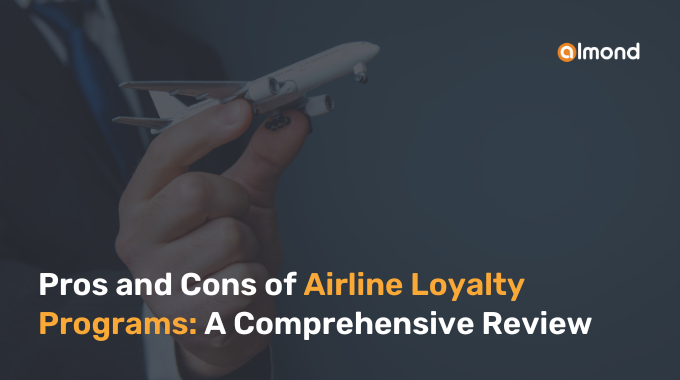Airline loyalty programs have been around for decades, offering frequent flyers the opportunity to earn miles or points that can be redeemed for flights, hotel stays, and other rewards. While loyalty rewards programs can significantly benefit travelers, they also have their fair share of drawbacks.
In this blog, we will review the pros and cons of airline reward programs and explore how airlines are navigating these challenges.
Pros of Airline Loyalty Programs
Airlines have introduced frequent flyer programs as these can increase loyal customers. Some advantages that lead to this conclusion are as follows:
Free Flights and Upgrades
The most significant benefit of airline reward programs is free flights and upgrades. Frequent flyers can earn miles or points by booking flights, using credit cards, or staying at partner hotels. These miles can be redeemed for flights, upgrades, or other rewards, significantly saving travelers.
Take an example of Delta Air Lines’ SkyMiles rewards program, which allows travelers to earn miles by booking flights, using Delta’s credit cards, or staying at partner hotels. These miles can then be redeemed for flights, upgrades, or other rewards, providing significant value to frequent flyers.
Priority Treatment
Another benefit of airline reward programs is the priority treatment given to frequent flyers. Elite members of reward programs are often given priority boarding, access to priority security lines, and other perks that make travel more comfortable and convenient.
For example, United Airlines offers a MileagePlus rewards program, which offers Premier status to its most frequent flyers. These members are given priority boarding, access to priority security lines, and other perks that make travel more comfortable and convenient.
Partner Programs
Airline reward programs often offer partner programs, allowing members to earn miles or points through other means, such as credit card spending, hotel stays, or car rentals. It provides more opportunities for members to earn rewards and other incentives, even when they are not traveling.
American Airlines offers its AAdvantage rewards program. It is considered one of the best airline loyalty programs, which allows members to earn miles through credit card spending, hotel stays, and car rentals. It provides more opportunities for members to earn rewards and redeem them for flights or other rewards.
Cons of Airline Reward Programs
Even though loyalty programs are profitable, some checks and balances should be considered. Airline companies must consider these checks while creating and running loyalty programs.
Complex Rules and Restrictions
In airline loyalty programs, redemption options can be limited, and blackout dates and other restrictions often make it challenging to redeem rewards.
For example, some airlines may limit the number of reward seats available, making it difficult to redeem miles for a flight. Similarly, some airlines may have blackout dates during peak travel times, making redeeming rewards during these periods challenging.
Expiration Dates
Another drawback of airline reward programs is the expiration dates that come with the rewards. Miles or points earned through reward programs may have expiration dates, making it challenging to accumulate enough rewards to redeem for a significant benefit.
For example, Delta Air Lines’ SkyMiles rewards program requires members to earn or redeem miles every 12 months to keep their account active. Failure to do so will result in the loss of any accumulated miles.
Devaluation of Points
Airline reward programs can also suffer from the devaluation of points, which occurs when airlines increase the miles or points required to redeem them. Frequent flyers can find it challenging to accumulate enough rewards to redeem for a significant benefit.
For example, in 2014, Delta Air Lines increased the miles required to redeem some of its rewards, making it more challenging for members to redeem them.
Navigating the Pros and Cons
While airline reward programs have pros and cons, airlines constantly work to navigate these challenges. For example, some airlines are introducing more flexible redemption options, making it easier for members to redeem their rewards. Others are introducing new partnerships to provide more opportunities for members to earn rewards.
For example, Delta Air Lines introduced its SkyMiles program, offering members benefits such as priority boarding, free checked bags, and discounted Delta Sky Club memberships. This program allows members to earn rewards without accumulating miles or points, providing more flexibility.
Another example is Southwest Airlines’ Rapid Rewards program, which allows members to redeem rewards for any available flight with no blackout dates. It provides members with more flexibility in redeeming their rewards and makes it easier to find available flights to redeem their rewards.
In addition to these changes, airlines are working to improve their reward programs by providing more value to their members. For example, some airlines are introducing more premium rewards, such as access to exclusive airport lounges, private jet charters, or experiences such as culinary tours or concert tickets.
Conclusion
Airline reward programs offer significant benefits for frequent flyers, such as free flights, priority treatment, and partner programs. However, they also come with drawbacks. That’s why airlines constantly work to improve their loyalty programs and provide more value to their members.
As travelers navigate the post-COVID world, airline loyalty programs may become even more important as airlines look to attract customers back to the skies. By understanding the pros and cons of these programs and how airlines navigate these challenges, travelers can make informed decisions about which reward programs to participate in and how to maximize their rewards.







